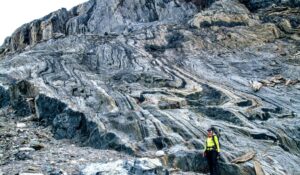We all remember that iconic shot of Wyoming’s Devil’s Tower in Steven Spielberg’s Close Encounters of the Third Kind: the famous landmark silhouetted by a dark, ominous UFO. The unique geological feature is a group of perfect geometrical columns which are called columnar jointing.
How are they formed?
Columnar jointing is actually several fractures or joints grouped together. These rock columns result from the cooling of the lava and subsequent contraction of the rock. This leads to squared, pentagonal, hexagonal, or heptagonal-shaped columns. The number of sides depends on the number of fractures present in the rock.
Usually, the columns are straight but they can be curved depending on the circumstance of their formation. They can reach up to 50m long. However, the columns often vary in length, giving the effect of steps or levels. The smaller the column, the more rapidly the rock was cooled. Lengthy columns are where the rock took a longer time to cool.

Devil’s Tower in Wyoming. Photo: Inbound Horizons/Shutterstock
The main rock in these columns is basalt. Basalt is an igneous rock that forms when fast-flowing lava cools rapidly on the earth’s surface. It comprises most of the Earth’s volcanic rock at a whopping 90%. This type of volcanic material can take the form of columns and prisms with perfect geometrical shapes.
Famous examples
In Europe, some famous examples include Giant’s Causeway in Northern Ireland, Fingal’s Cave in Scotland, and Stuðlagil in Iceland. In North America, there’s Devil Tower, Devil’s Postpile in California, and Sheepeater Hills in Yellowstone National Park. Other examples are Cape Raoul in Tasmania, Basaltic Prisms of Santa María Regla in Mexico, and Ganh Da Dia in Vietnam. There are around 200 known examples of columnar jointing in the world.
Giant’s Causeway was formed around 60 million years ago during the Paleocene Epoch. This era saw heightened volcanic activity in England, Ireland, and Scotland. Basalt lava formed a plateau which then cooled and subsequently fractured into interlocking columns and natural geometric pavements. The Causeway is made of 40,000 columns, ranging from squared to hexagonal-sided.
Scotland’s Fingal’s Cave formed in the same epoch as the Giant’s Causeway. In terms of local folklore, the ancient legend states that giants built the columns in order to cross into Scotland.

Basalt columns in Iceland. Photo: Shutterstock
While Devil’s Tower in Wyoming is classified as a basalt column, it is actually made from a rarer material called phonolite porphyry. These columns form due to fracturing and erosion from freezing and refreezing. We are not sure about the precise mechanism of its formation but likely it is what remains of an ancient laccolith. A laccolith forms when igneous rock forms a dome when rising to the Earth’s surface. Despite its mystery, the Devil’s Tower is one of the most famous American landmarks.
The Basalt Prisms of Santa María Regla in Mexico refer to the canyon walls of a ravine by the San Antonio Dam. The pentagonal and hexagonal columns measure up to 50m long. The walls slope downward, creating a running waterfall. Like Giant’s Causeway, the slope looks like natural steps.

Basaltic Prisms in Mexico. Photo: Javier Garcia/Shutterstock
Climbing potential?
Unfortunately, these columns are highly susceptible to weathering. This is because basalt is made of magnesium and iron. Iron oxidizes and breaks down very fast. Basalt also contains two minerals, pyroxene and plagioclase, which tend to break easily.
Basalt’s many bubbles allow it to absorb more water. Despite these drawbacks, basalt is still used in construction and has environmental benefits. Some basalt formations can remain sturdy, if not too weathered.
When it comes to climbing basalt, it is a hit or miss. It is possible to climb basalt columns but one needs to be mindful of the amount of erosion and weathering. Columns very close to the sea, in particular, may be softer and more unstable. However, the columns have great potential for climbing since they have lots of cracks, grooves, fractures, holes, and other features for a decent grip.






